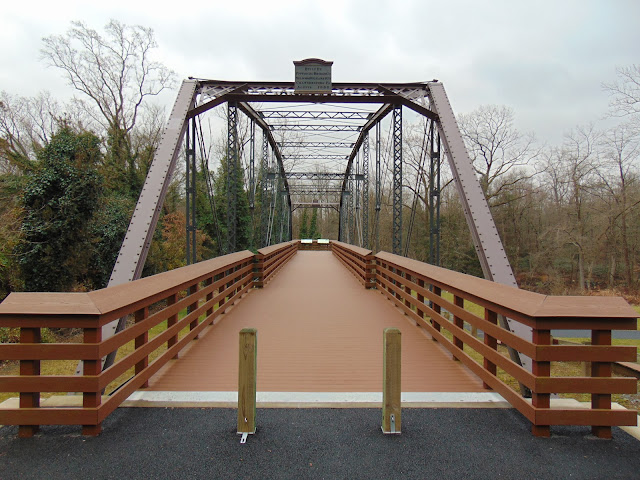The Youghiogheny River town of West Newton is one of many river towns that line the Monongahela or Yough Rivers. Like many, West Newton was settled in the early pioneer days of the late 1700s, transitioned to supporting numerous industries in the 19th and early 20th centuries, and began to forge a new identity in the late 20th and early 21st centuries.
 |
| Downtown West Newton (William G. Prince) |
For West Newton, the town began as the site of a small family run ferry across the Youghiogheny. The Simeral family, who ran the ferry, was the first to settle in the area. In 1788, a group of Revolutionary War veterans camped here in winter, built boats, and headed west into Ohio. These war veterans from Ipswich, Massachusetts would settle what is now the town of Marietta, Ohio. (1)
 |
| This Parker Truss Bridge over the Youghiogheny River has been a fixture of West Newton since 1907. (Adam Prince) |
Later, a veteran of the Whiskey Rebellion, Isaac Robb, would lay out the town. Originally called Robbstown, West Newton was incorporated in 1842. The town was originally home to a paper mill; but in the late 1800s, the
US Radiator Corporation opened a factory at the old paper mill site.
As West Newton grew, a downtown developed with
a number of historic buildings that still stand today.
 |
| The 1890 Mungo Dick Building (Adam Prince) |
The Mungo Dick Building, built in 1890, is a three-story L shaped brownstone known most for the semi-circle turret that overlooks the intersection of Main and Second Streets. The building which saw additions made in 1910 and 1925 - once was home to the Farmers & Merchants bank on the first floor. Unfortunately, the bank failed in 1931. The building is still home to several first floor businesses today while apartments are on the second and third floors. The Dick Building was added to the National Register of Historic Places in 2007.
 |
| The 1902 PNC Bank Building. In the bottom photo, you can see the obverse of a 1902 Morgan Silver Dollar. (Top - Adam Prince / Bottom - William G. Prince) |
Across the street is another historic bank building that is now home to PNC Bank. The Romanesque sandstone building was built in 1902 and once had three floors. One of the more notable features of the building is the
full obverse and reverse of a 1902 Morgan Silver Dollar that stand above the entrance doors.
 |
| The Weimer Department Store Building (William G. Prince) |
Just up the hill from the PNC Bank Building is the former Weimer Department Store building. The building dates to prior to the Civil War. When S.C. Weimer purchased the building in 1880, he updated the façade to what you see today.
 |
| The Plumer House. To the left is the 1814 wood-frame home, the right the 1846 brick addition. (William G. Prince) |
West Newton has a second set of buildings listed on the National Register of Historic Places. The Plumer House first built in 1814 with an addition done in 1846 was added to the Register in 1979. The building is located at the corner of South Water & Vine Streets.
 |
| West Newton United Presbyterian Church (Top: Adam Prince / Bottom: William G. Prince) |
Downtown West Newton is home to two historic churches. The United Presbyterian Church dates to 1879. The first church for the congregation dates back to 1850.
 |
| West Newton United Methodist Church at Christmas (Adam Prince) |
The United Methodist Church dates to 1880 and its Snyder Chapel is named after John L. Snyder.
Like many other towns in the region, West Newton struggled as a result of lost industry during the mid-20th Century. US Radiator closed in 1955 taking several hundred jobs with it. However, it was the abandonment of the Pittsburgh & Lake Erie railroad on the western banks of the Youghiogheny that became to the town's revival.
During 1990s, work began to convert the abandoned P&LE railroad in the West Newton area into a bike trail. The then-named Yough River Trail began in the late-1970s with a purchased of over 26 miles of the former right of way of the Western Maryland Railway in Fayette County. In 1986,
9.5 miles of trail opened in Pennsylvania's Ohiopyle State Park and saw yearly increases in usage.
 |
| Great Allegheny Passage and the West Newton Bridge (William G. Prince) |
Over time, that momentum carried northwards towards Pittsburgh and the creation of the Yough River Trail would begin to offer a new industry, recreational tourism, to West Newton and surrounding communities.
In 2001, the Yough River Trail changed its name to the
Great Allegheny Passage with the goal of having a continuous bike trail from Point State Park in Pittsburgh to Cumberland, Maryland. A distance of 150 miles. On June 15, 2013 -
with the opening of a small section at Sandcastle Waterpark in Pittsburgh - the Great Allegheny Passage was complete.
 |
| The Great Allegheny Passage (GAP Trail) at the remodeled West Newton P&LE Station that is now home to a visitors center. (William G. Prince) |
West Newton is one of the featured towns along the Passage and has totally embraced the bike trail from the start. The town is home to a visitor center which is located in a restored 1905 P&LE Rail Station. Many riders will cross over the West Newton Bridge - built in 1908 -
into town for a meal,
sample a local brewery, ice cream,
bike supplies & repairs,
camp or even a
stay at a local Bed & Breakfast.
Thanks to my brother William for allowing me to include some of his photos.
Further Reading:
How To Get There:
















Comments
Post a Comment